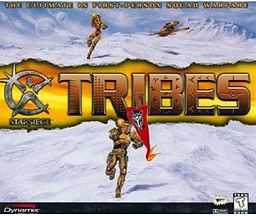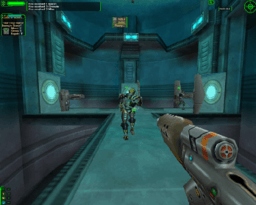Starsiege: Tribes
| Starsiege: Tribes | |
|---|---|
 | |
| Developer(s) | Dynamix |
| Publisher(s) | Sierra On-Line |
| Designer(s) | Scott Youngblood |
| Series | Tribes |
| Engine | Darkstar |
| Platform(s) | Microsoft Windows |
| Release date(s) | November 30, 1998 2004 (freeware) |
| Genre(s) | First-person shooter |
| Mode(s) | Single-player, multiplayer |
| Distribution | CD-ROM |

Starsiege: Tribes is a sci-fi first-person shooter video game. It is the first of the Tribes video game series and follows the story from Earthsiege and Starsiege. It was developed by Dynamix and published by the company now known as Sierra Entertainment in 1998. An expansion pack, Tribes Extreme, was cancelled. It was supposed to add single-player missions, multiplayer maps and bot AI.[1]
History
A sequel, Tribes 2, was released in March 2001. Sierra licensed the franchise to Irrational Games for a third installment, Tribes: Vengeance, which was released in October 2004.
Vivendi Universal released Tribes and Tribes 2 for free on May 4, 2004 on a DVD-ROM with Computer Gaming World magazine and on FilePlanet, in order to promote the release Tribes: Vengeance.[2]
On July 16, 2007, Sierra Entertainment announced that they would cease online support of Tribes starting on August 16, 2007.[3] As of November 2007, the Sierra Master Server is no longer active, and has been replaced by multiple community-run Master Servers.[citation needed]
In March 2009, GarageGames announced they had purchased the Intellectual property and source code for Starsiege: Tribes and would be releasing it at PlayTribes.com through an update on their browser-based game service, InstantAction.[4] PlayTribes was available for play during the 2009 Penny Arcade Expo at InstantAction's display in the expo hall.[5]
On October 23, 2010, it was announced that Hi-Rez Studios were the new owners of the Tribes franchise, thus canceling development on PlayTribes.[6] The company released Tribes: Ascend in April 2012.
Gameplay
Tribes is a squad-based multiplayer online game with no single-player campaign; it is similar in this respect to the Team Fortress and Enemy Territory games. The story is set in the 40th century, after humanity has settled across the galaxies via jumpgates. Conflict has broken out between several factions of humans, the four largest of which are the Children of the Phoenix, Blood Eagle, Diamond Sword, and Starwolf. The first and largest descends from people isolated from the Great Human Empire during the jumpgate diaspora. The second is a force of imperial knights originally sent from the Empire to subdue them who have gone 'tribal' over time. The Diamond Sword and Starwolf are secondary, with innumerable other splinter tribes constantly fighting for territory. The player assumes the role of a warrior loyal to one of the four major tribes battling in the front lines of the conflict.
The battles take place on one of 40 maps. Most of the standard maps are outdoors environments in a variety of climates, from sunshine to snow and hail. In general, bases are scattered throughout the map depending on the gametype. The outdoor environments can extend for several kilometers.
There are five distinct "default" gametypes:
- Capture the flag (CTF) - Each team (up to eight, normally less than three on any given mission) has one or more bases and a single flag. Each team tries to take an opposing team's flag and touch it to their own, which "captures" the flag and awards the capturing team a point. If a flag carrier is killed, the flag is dropped; the flag can be picked up by a teammate to finish the capture, instantly returned to its base by a member of the flag's team, or returned after a certain interval of time. Stalemates often occur when multiple teams' flags are taken at the same time; a team's flag must be at its base to accomplish a "cap". Capture the Flag is a popular mode, with 75 percent of servers running this game type.[7]
- Deathmatch (DM) - It can be played with or without teams; in both cases, players must get the highest number of kills to win.
- Capture and hold (C&H) - Teams must seek out capturable bases or other assets, sometimes complete with turrets and stations, throughout the map. Points are given based on the amount of time an asset is "owned".
- Defend and destroy (D&D) - Players on a team must destroy certain items in an enemy's base before the enemy does the same to their base. Subsequent team-based First-person shooter games, however, did use variations of the concept (such as with Unreal Tournament and its "assault" game type). Defend and Destroy is the second-most popular game type.[7]
- Find and retrieve (F&R) - A number of flags are scattered across the mission area. Team members must find and bring them back to their base. The flags can be captured from the enemy as well. The team to capture all the flags wins.
- Multiple Team: Multiple teams must fight against each other to retain control of an objective or to capture the enemies' flag.
- Speedball/Paintball: Similar to capture the flag, Speedball, also known as Paintball, is a game setting in which you had paintball guns that where one hit kills, regardless of the gun used. The map was limited to custom set building in which both teams was put on different sides of the map. The first team to reach a certain number of flag captures, win, then the next round would start on another terrain.
- Open Call: Open Call isn't necessarily a game mode per se, but a collection of missions created by map makers after a contest held by Dynamix.[8]
Each player wears either light, medium or heavy armor. Heavier armors supply larger amounts of armor, energy, and ammunition. Different armor types support different weapons and equipment; for example, only the heavy armor supports the heavy mortar but only light armor supports the sniper rifle.[7] When damage is dealt to the player (by falling or being hurt by a weapon), armor is lost. Loss of all armor results in the player's death. After dying, the player respawns at the team's base (or somewhere in the field). Players also have an energy cell, which is drawn on for jetting, firing some kinds of weapons, and activating packs. The different armor types can be accessed at an inventory station.
There are various items of equipment usable by the players, including vehicles, eight weapons, and "Packs" which alter the abilities of the player. On some maps, bases include various defense mechanisms and other tools to assist the team: Generators, turrets, stations and sensors. Generators provide power to systems. Destroying them can disable an entire team's defense by deactivating turrets and stations. They are also among the objectives in the "Defend & Destroy" gametype. Turrets come in five varieties. They can all be destroyed by sustained fire and their shields can be drained by an ELF. Stations are where players get equipment or monitor the base. Sensors scan a radius for enemies and allow players to view troop movements in the PDA (Personal Digital Assistant). There are large and small varieties.
Weapons include the heavy mortar, sniper rifle, explosive disc launcher, short-range gatling gun, grenade launcher, blaster, plasma rifle and laser rifle. The heavy mortar is considered to be a good weapon for taking out base defenses from afar.[7] The sniper rifle is the only hitscan weapon, with the others firing relatively slow projectiles.[7]
The PDA is intended to provide information to commanders and give detailed information on the team's situation. Among other things, players can issue commands to teammates, view equipment status, monitor enemy activity (with sensors or hidden cameras), watch teammates in a miniature screen, and control turrets (although this must be done at a command station).
Movement
In addition to running and jumping, players are equipped with a jetpack which allows them to accelerate into the air until the armor's energy is used up. In addition to straight-line movement, the jetpack has other versatile uses. It can be used to make short hops whilst zig-zagging to make a player harder to target in open areas. An upward thrust can help the player evade oncoming enemies armed with short-range weapons.[9]
Another method of movement is known as "skiing", and relies on an exploitation of the game's physics engine.[10] If a player taps the jump button with the correct timing whilst descending a hill, their momentum will accumulate. High speeds can be achieved this way, and if this momentum takes the player to the crest of another hill, the jetpack can be used to rapidly propel them across the map.[9] This technique was later developed into a game feature by Dynamix for Tribes 2.[11]
Reception
| Reception | ||||||||||||||||||||||||||||||||||||||||||||||||||||||||||||||||||||||||
|---|---|---|---|---|---|---|---|---|---|---|---|---|---|---|---|---|---|---|---|---|---|---|---|---|---|---|---|---|---|---|---|---|---|---|---|---|---|---|---|---|---|---|---|---|---|---|---|---|---|---|---|---|---|---|---|---|---|---|---|---|---|---|---|---|---|---|---|---|---|---|---|---|
| ||||||||||||||||||||||||||||||||||||||||||||||||||||||||||||||||||||||||
GameSpot awarded 8.6 out of 10, considering Tribes to be an almost perfect balance between gameplay, online connectivity and speedy performance. The multiplayer gameplay drew comparisons with NovaLogic's Delta Force, with good visuals and customizable weapon loadouts. The maps were highlighted as being wonderfully rendered, with seamless indoor-outdoor transitions. Criticisms included the difficulty in conducting long-range combat, a lack of close-combat weapons and the queues that form at weapon consoles. It was felt that Tribes would have benefited from a stronger training mode and better handling of scores and statistics.[7]
See also
|
- List of free first-person shooters
- Tribalwar
- Fallen Empire: Legions
- PlayTribes
- Tribes: Ascend
References
- ↑ "Tribes Extreme Interview". IGN. Ziff Davis. 14 October 1999. Retrieved 28 November 2013.
- ↑ By Julio. "Get Tribes and Tribes 2 free - TechSpot News". Techspot.com. Retrieved 2012-06-17.
- ↑ "Notice of Multiplayer Functionality Termination for 20 Sierra Entertainment Heritage Titles". GameSpot.
- ↑ Fahey, Mike. "InstantAction Brings Tribes To Your Web Browser". Kotaku.
- ↑ John Callaham (5 September 2009). "PAX 2009: InstantAction Tribes hands-on impressions". Big Download.
- ↑ Hi-Rez Announce Tribes Universe
- ↑ 7.0 7.1 7.2 7.3 7.4 7.5 7.6 Michael E. Ryan (1999-01-22). "Starsiege Tribes Review". GameSpot. Retrieved 2008-10-13. "Tribes is an ambitious game that successfully delivers a rich and addictive multiplayer gaming experience. Any team-minded action fan will love this game, and I suspect that more than a few freelance types will also."
- ↑ Join the Tribe
- ↑ 9.0 9.1 Lambert, Kornel. "PC Cheats: Starship: Tribes". Computer and Video Games. Future Publishing. Retrieved 2009-07-09.
- ↑ Butts, Steve. "Tribes: Vengeance Review". IGN. Retrieved 2009-09-07.
- ↑ "Tribes 2 Review". GameSpot. Retrieved 2009-07-09.
- ↑ 12.0 12.1 12.2 "Starsiege Tribes Reviews". Game Rankings. Retrieved 2008-10-13.
- ↑ Trent C. Ward (1999-01-15). "Starsiege: Tribes Review". IGN.
External links
- Starsiege: Tribes at MobyGames - Game Archive and Review site documenting Credits, Shots and reviews
- Starsiege: Tribes on the Open Directory Project
| ||||||||||||||